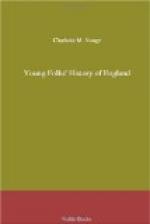Marshal St. Arnaud, were landed in the Crimea, where
they gained a great victory on their first landing,
called the battle of the Alma, and then besieged the
city of Sebastopol. It was a very long siege,
and in the course of it the two armies suffered sadly
from the cold and damp, and there was much illness;
but a brave English Lady, named Florence Nightingale,
went out with a number of nurses to take care of the
sick and wounded, and thus she saved a great many lives.
There were two more famous battles. One was
when six hundred English horsemen were sent by mistake
against a whole battery of Russian cannon, and rode
on as bravely as if they were not seeing their comrades
shot down, till scarcely half were left. This
was called the Charge of Balaklava. The other
battle was when the Russians crept out, late in the
evening of November 5, to attack the English camp:
and there was a dreadful fight by night and in the
early morning on the heights of Inkerman; but at last
the English won the battle, and gave the day a better
honor that it had had before. Then came a terrible
winter of watching the city and firing at the walls;
and when at last, on the 18th of June, 1855, it was
assaulted, the defenders beat the attack off; and
Lord Raglan, worn out with care and vexation, died
a few days after. However, soon another attack
was made, and in September half the city was won.
The Emperor of Russia had died during the war, and
his son made peace, on condition that Sebastopol should
not be fortified again, and that the Russians should
let the Turks alone, and keep no fleet in the Black
Sea.
In this war news flew faster than ever it had done
before. You heard how Benjamin Franklin found
that electricity—that strange power of
which lightning is the visible sign—could
be carried along upon metal wire. It has since
been made out how to make the touch of a magnet at
one end of these wires make the other end move so that
letters can be pointed to, words spelt out and messages
sent to any distance with really the speed of lightning.
This is the wonderful electric telegraph, of which
you see the wires upon the railway.
CHAPTER XLIX.
Victoria. A.D. 1857—1860.
Peace had been made after the Crimean war, and everybody
hoped it was going to last, when very sad news came
from India. You know I told you the English
people had gone to live in India, and had gradually
gained more and more lands there, so that they were
making themselves rulers and governors over all that
great country. They had some of the regiments
of the English army to help them to keep up their power,
and a great many soldiers besides—Hindoos,
or natives of India, who had English officers, and
were taught to fight in the English manner. These
Hindoo soldiers were called Sepoys. They were
not Christians, but were some of them Mahommedans,
and some believed in the strange religion of India,
which teached people to believe in a great many gods—some
of them very savage and cruel ones, according to their
stories, and which forbids them many very simple things.
One of the things it forbids is the killing a cow,
or touching beef, or any part of it.




